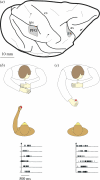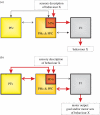From monkey mirror neurons to primate behaviours: possible 'direct' and 'indirect' pathways
- PMID: 19620103
- PMCID: PMC2865083
- DOI: 10.1098/rstb.2009.0062
From monkey mirror neurons to primate behaviours: possible 'direct' and 'indirect' pathways
Abstract
The discovery of mirror neurons (MNs), deemed to be at the basis of action understanding, could constitute the potential solution to the 'correspondence problem' between one's own and others' action that is crucial for of imitative behaviours. However, it is still to be clarified whether, and how, several imitative phenomena, differing in terms of complexity and cognitive effort, could be explained within a unified framework based on MNs. Here we propose that MNs could differently contribute to distinct imitative behaviours by means of two anatomo-functional pathways, subjected to changes during development. A 'direct mirror pathway', directly influencing the descending motor output, would be responsible for neonatal and automatic imitation. This proposal is corroborated by some new behavioural evidences provided here. During development, the increased control of voluntary movements and the capacity to efficiently suppress automatic motor activation during action observation assign to the core MNs regions essentially perceptuo-cognitive functions. These functions would be exploited by an 'indirect mirror pathway' from the core regions of the MN system to prefrontal cortex. This latter would play a key role in parsing, storing and organizing motor representations, allowing the emergence of more efficient and complex imitative behaviours such as response facilitation and true imitation.
Figures




References
-
- Abravanel E., Sigafoos A. D.1984Exploring the presence of imitation during early infancy. Child Dev. 55, 381–392 (doi:10.2307/1129950) - DOI - PubMed
-
- Addessi E., Galloway A. T., Visalberghi E., Birch L. L.2005Specific social influences on the acceptance of novel foods in 2–5-year-old children. Appetite 45, 264–271 (doi:10.1016/j.appet.2005.07.007) - DOI - PubMed
-
- Anderson J. R., Myowa-Yamakoshi M., Matsuzawa T.2004Contagious yawning in chimpanzees. Proc. Biol. Sci. 271(Suppl. 6), S468–S470 (doi:10.1098/rsbl.2004.0224) - DOI - PMC - PubMed
-
- Armand J., Olivier E., Edgley S., Lemon R. N.1996The structure and function of the developing corticospinal tract: some key issue. In The neurophysiology and psychology of hand movements (eds Wing H. A., Haggard P., Flanagan J. R.), pp. 125–145 San Diego, CA: Academic Press
-
- Bauer J., Held R.1975Comparison of visually guided reaching in normal and deprived infant monkeys. J. Exp. Psychol. Anim. Behav. Process 1, 298–308 (doi:10.1037/0097-7403.1.4.298) - DOI - PubMed
Publication types
MeSH terms
Grants and funding
LinkOut - more resources
Full Text Sources

